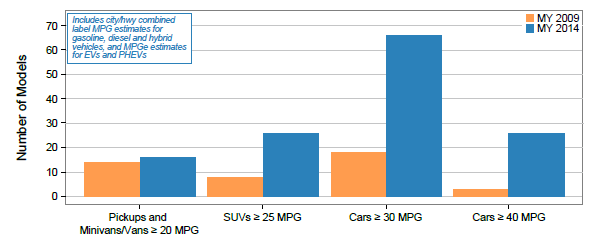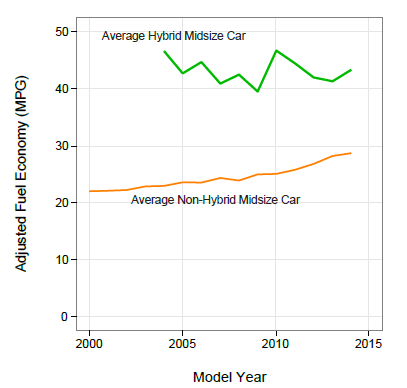The annual LA Auto Show opens this week with announcements from numerous automakers planned for Wednesday and Thursday before the first public day on Friday. I’ll be headed down to the show to check-out what automakers have to offer and see how 2015 is shaping up in terms of fuel efficient and alternative fuel vehicles.
The auto show comes on the heels of an EPA report released in October showing that the average new fuel economy of vehicles produced in model year 2013 was the highest it’s ever been, thanks to the adoption of technologies which are making every kind of vehicle go farther on a gallon of gas. New vehicle fuel economy improved by 7% compared to 2010, resulting in fuel savings to new car buyers of $2.2 billion in 2013 alone. Fuel economy and greenhouse gas standards as well as California’s Zero Emission Vehicle program have been key contributors to the technology trends identified in EPA’s report – pushing automakers to deploy innovative technologies that are saving consumers money at the pump. At the show this week I’ll be looking to see how these state and federal policies are influencing technology choices by manufacturers and to see if recent trends continue into 2015 and beyond (and my colleague Lucy Litvak will be tweeting live updates from the show – follow her @UCSLucy on Twitter).
Below are some of the things I’ll be looking for at the show. If you have thoughts on other fuel economy technologies you’re looking for from automakers this year, please post your thoughts in the comments:
(1) Fuel economy improvements in all segments
Reducing fuel use and emissions from U.S. vehicles doesn’t mean that everyone needs to drive a compact car. Technologies are available to improve vehicle efficiency no matter if the vehicle is a small compact or a heavy-duty pick-up truck. In fact, the standards are designed with this in mind, setting appropriate performance requirements based on the footprint of the vehicle. As a result, recent trends show fuel economy is improving across all categories of vehicles and carbon emissions are dropping after a period of stagnation throughout the 90’s and early 2000’s (see figure below).

CO2 Emissions and Fuel Economy by Vehicle Type. Fuel economy has improved in all vehicle categories over the last several years, driven by new standards for efficiency and greenhouse gas emissions. Source: Adapted from EPA’s Trends Report figure 3.5.
In practical terms, this means consumers are getting more high fuel economy options to choose from in every category. This figure below from the trends report shows how the number of high mpg models has increased between model year 2009 and 2014. The biggest gains have been in cars exceeding 30 mpg. The vehicles in this category have more than tripled since 2009 with more than 60 models—about half being conventional gasoline or diesel, with the remainder being hybrids and plug-in vehicles.

The number of high mpg models has increased across different vehicle categories over the past 5 years. Source: Adapted from EPA’s Trends Report figure 3.5.
What to look for at the auto show: More models across vehicle categories achieving “best in class” fuel economy, especially pick-ups and minivans.
(2) Gasoline direct injection, turbocharging and engine downsizing
These technologies, which can improve engine efficiency and overall vehicle fuel economy, are being adopted by many manufacturers to meet fuel economy requirements. For example, gasoline direct injection is expected to reach 38% market share for 2014, despite only being introduced in the market in small numbers in 2007. Kia, Daimler, and BMW are already using the technology in the majority of their production vehicles, but other automakers haven’t adopted the technology at the same rate.
GDI technology is often paired with turbocharging and engine downsizing to allow for even greater efficiency gains from using a smaller displacement engine. Turbo charging has been around for years, often being used to increase engine power on performance vehicles. However, turbocharging can also be used with a smaller engine to maintain vehicle performance while increasing fuel economy. Ford’s EcoBoost engines use this technology and have implemented the configuration in a 3 cylinder variant available in the Fiesta.
What to look for at the auto show: See if the trend continues with new models from different manufacturers being offered with GDI and turbo charged and downsized engines, particularly in non-performance, high volume models.
(3) Hybrid improvements
The Prius and its cousins, the Prius V and Prius C, continue to dominate the hybrid market, currently accounting for a little more than 40% of all hybrid sales. However, hybrid sales have slowed somewhat this year which may in part be due to the improvement in conventional gasoline technology closing the gap in fuel consumption between the two. EPA’s trends report shows that the gap between the average non-hybrid and hybrid midsize vehicles is shrinking (see figure). The mpg advantage of hybrids has dropped from about a 24 mpg in 2004 to about 15 in 2014. That might not seem like a big difference, but for someone who drives 15,000 miles a year, annual fuel savings would go from $1000/year to less than $600 assuming a gas price of $3.00/gallon.
Improvements in the Prius are expected next year, and the improvement to other hybrid models in terms of either lowered technology costs or better mpg could help improve hybrid sales.
What to look for at the auto show: New models or improvements to existing hybrid models to improve vehicle fuel economy or reduce costs.

Hybrid and Non-Hybrid Fuel Economy for Midsize Cars, MY 2000 -2014. The fuel economy advantage of hybrids compared to conventional vehicles has, on average, declined over the past 10 years. Source: EPA Trends Report Figure 5.10.
(4) Cylinder deactivation
This technology, which saves fuel by turning off fuel to parts of the engine when less power is needed, has grown in popularity, especially among trucks—reaching an estimated 25% of vehicles in model year 2014, up from less than 1 percent in 2005.
What to look for at the auto show: More models of cars and trucks employing the technology.
(5) Start-stop systems
Daimler and BMW have led the way in adoption of non-hybrid start-stop systems which eliminate vehicle idling at stop lights and at other times when the vehicle is stopped. Other manufactures are incorporating the technology as well, with GM dropping it in their 2015 Chevy Impala and the 2014 Malibu while Ford is offering it on a variant of the 2015 F150 (Ford anticipates fuel economy numbers for the new F150 to be out in November, so maybe we’ll hear some news about it at the show). About 6% of vehicles in 2014 are expected to have start-stop technology.
What to look for at the auto show: More models from different manufacturers offering stop-start technology.
(6) Transmissions
The 5-speed manual currently parked in my garage is quickly becoming a relic of the past. And for good reason. Stick shift transmissions were often favored in the past for their superior fuel economy compared to automatic transmissions. However, improvements in automatic transmissions have closed the gap between these technologies, all but eliminating any advantage for manuals. The recent rise in 7 and 8 speed automatic transmissions is expected to continue with 9 or more speed transmissions entering the market – the Jeep Grand Cherokee being one model already available with a 9-speed transmission.
What to look for at the auto show: More models with automatic transmission with 8,9 or more gears as well as greater use of CVTs and dual clutch transmissions.
(7) High strength, lightweight materials
Ford made big news last year with the adoption of aluminum body panels on the redesigned F150, while the BMW i3 also turned some heads with its use of a carbon fiber body. Using more light weight high strength materials is expected to be an on-going trend to help reduce vehicle weight and improve fuel economy.
What to look for at the auto show: More announcements around increased use of lightweight materials in both body and drivetrain components.
(8) Electric vehicles
Starting with 2 models in 2011 there has been a steady stream of new plug-in electric models into the market – especially in CA – bringing the current total number of models to more than 20 and overall sales topping 250,000 nationwide. Redesigns or upgrades of some existing models have already shown improvements in efficiency, leading to even lower emissions from driving on electricity. GM might be saving the debut for the brand-new Volt for the Detroit Auto Show, but the Cadillac ELR is expected to debut some new features at the LA Auto Show.
Fuel cell electric vehicles have been a more recent development. Hyundai made headlines with the introduction of the Tucson fuel cell vehicle this summer and Toyota is bringing its fuel cell to market in 2015. As we found with our lifecycle assessment of the Tuscon – the fuel cell version powered on CA’s required mix of 33% renewable hydrogen has the global warming emissions equivalent to a 54 mile per gallon gasoline vehicle. There’s likely to be continued attention on fuel cells at this year’s auto show (it was a topic of interest last year as well) with Toyota’s upcoming vehicle introduction in 2015.
What to look for at the auto show: Details on Toyota’s vehicle are still lacking, preventing us from estimating the global warming emissions we might expect from the production vehicle. I’ll be looking for more details from Toyota on their fuel cell vehicle and announcements from other automakers related to their plug-in and fuel cell vehicles.
(9) Diesel vehicles
Diesel continues to shake off its it high polluting image with more models entering the market every year equipped with modern emission controls. These vehicles often come with impressive mpg ratings in part due to the greater efficiency of diesel engines and the higher energy content in a gallon of diesel. But as my colleague Dave Cooke writes, make sure you do an apples to apples comparison when comparing diesel and gasoline vehicles for their climate emissions. For example, a diesel vehicle with a fuel economy rating of 36 mpg produces the same amount of global warming emission as 30 mpg gasoline vehicle. Check out the calculator in Dave’s post to do your own comparisons.
One trend that is apparent from EPA’s analysis is that manufacturers tend to get the most improvements out of diesel’s in the smaller vehicle segment, while the carbon emissions advantage for larger vehicles is diminished – indicating a possible focus on power over full economy for larger vehicles.

CO2 emissions for Diesel Vehicles compared to Non-Diesel, Model Year 2013. The advantage of diesels compared to non-diesel erodes in larger vehicles. Source: EPA Trends Report figure 5.13.
What to look for at the auto show: Are new diesel vehicles offering consumers valuable fuel economy improvements, or providing higher power and performance in larger luxury vehicles at the expense of mpg improvements?

